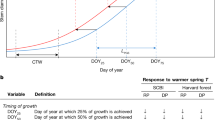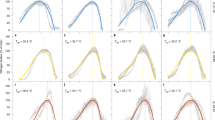Abstract
Fossils demonstrate that deciduous forests covered the polar regions for much of the past 250 million years1 when the climate was warm and atmospheric CO2 high2. But the evolutionary significance of their deciduous character has remained a matter of conjecture for almost a century3. The leading hypothesis1,4,4,5,6,7 argues that it was an adaptation to photoperiod, allowing the avoidance of carbon losses by respiration from a canopy of leaves unable to photosynthesize in the darkness of warm polar winters8,9,10,11. Here we test this proposal with experiments using ‘living fossil’ tree species grown in a simulated polar climate with and without CO2 enrichment. We show that the quantity of carbon lost annually by shedding a deciduous canopy is significantly greater than that lost by evergreen trees through wintertime respiration and leaf litter production, irrespective of growth CO2 concentration. Scaling up our experimental observations indicates that the greater expense of being deciduous persists in mature forests, even up to latitudes of 83 °N, where the duration of the polar winter exceeds five months. We therefore reject the carbon-loss hypothesis as an explanation for the deciduous nature of polar forests.
This is a preview of subscription content, access via your institution
Access options
Subscribe to this journal
Receive 51 print issues and online access
$199.00 per year
only $3.90 per issue
Buy this article
- Purchase on Springer Link
- Instant access to full article PDF
Prices may be subject to local taxes which are calculated during checkout



Similar content being viewed by others
References
Spicer, R. A. & Chapman, J. L. Climate change and the evolution of high-latitude terrestrial vegetation and flora. Trends Ecol. Evol. 5, 279–284 (1990)
Crowley, T. J. & Berner, R. A. CO2 and climate change. Science 292, 870–872 (2001)
Seward, A. C. Antarctic Fossil Plants. British Antarctic (‘Terra Nova’) Expedition, 1910. British Museum Natural History Report. Geology 1, 1–49 (1914)
Chaney, R. W. Tertiary centers and migration routes. Ecol. Monogr. 17, 139–148 (1947)
Hickey, L. J. Eternal summer at 80 degrees north. Discovery 17, 17–23 (1984)
Wolfe, J. A. in The Carbon Cycle and Atmospheric CO2: Natural Variations, Archean to Present (eds Sundquist, E. T. & Broecker, W. S.) 357–375 (Geophys. Monogr. Ser. 32, American Geophysical Union, Washington DC, 1985)
Falcon-Lang, H. J. & Cantrill, D. J. Leaf phenology of some mid-Cretaceous polar forests, Alexander Island, Antarctica. Geol. Mag. 138, 39–52 (2001)
Estes, R. & Hutchison, J. Eocene lower vertebrates from Ellesmere Island, Canadian Arctic Archipelago. Palaeogeogr. Palaeoclimatol. Palaeoecol. 30, 325–347 (1980)
Tarduno, J. A. et al. Evidence for extreme climatic warmth from Late Cretaceous arctic vertebrates. Science 282, 2241–2244 (1998)
Tripati, A., Zachos, J., Marincovich, L. & Bice, K. Late Paleocene Arctic coastal climate inferred from molluscan stable and radiogenic isotope ratios. Palaeogeogr. Palaeoclimatol. Palaeoecol. 170, 101–113 (2001)
Dutton, A. L., Lohmann, K. C. & Zinsmeister, W. J. Stable isotope and minor element proxies for Eocene climate of Seymour Island, Antarctica. Paleoceanography 17(2), 1016, doi:10.1029/2000PA000593 (2002)
Müller, M. J. Selected Climatic Data for a Global Set of Standard Stations for Vegetation Science (Kluwer Academic, Dordrecht, The Netherlands, 1981)
Beerling, D. J. & Osborne, C. P. Physiological ecology of Mesozoic polar forests in a high CO2 environment. Ann. Bot. 89, 329–339 (2002)
Osborne, C. P. & Beerling, D. J. A process-based model of conifer forest structure and function with special emphasis on leaf lifespan. Glob. Biogeochem. Cycles 16(4), 1097 doi:10.1029/2001GB001467 (2002)
Tjoelker, M. G., Oleksyn, J. & Reich, P. B. Modelling respiration of vegetation: evidence for a general temperature-dependent Q10 . Glob. Change Biol. 7, 223–230 (2001)
Read, J. & Francis, J. Responses of some Southern Hemisphere tree species to a prolonged dark period and their implications for high-latitude Cretaceous and Tertiary floras. Palaeogeogr. Palaeoclimatol. Palaeoecol. 99, 271–290 (1992)
Villar, R. & Merino, J. Comparison of leaf construction costs in woody species with differing leaf life-spans in contrasting ecosystems. New Phytol. 151, 213–226 (2001)
Yin, X. Responses of leaf nitrogen concentration and specific leaf area to atmospheric CO2 enrichment: a retrospective synthesis across 62 species. Glob. Change Biol. 8, 631–642 (2002)
Valdes, P. J., Sellwood, B. W. & Price, G. D. Evaluating concepts of Cretaceous equability. Palaeoclim. Data Modell. 2, 139–158 (1996)
Creber, G. T. & Chaloner, W. G. Tree growth in the Mesozoic and Early Tertiary and the reconstruction of palaeoclimates. Palaeogeogr. Palaeoclimatol. Palaeoecol. 52, 35–60 (1985)
Upchurch, G. R. & Askin, R. A. Latest Cretaceous and earliest Tertiary dispersed plant cuticles from Seymour Island. Antarct. J. US 24, 7–10 (1990)
Parrish, J. T., Daniel, I. L., Kennedy, E. M. & Spicer, R. A. Paleoclimatic significance of mid-Cretaceous floras from the middle Clarence Valley, New Zealand. Palaios 13, 149–159 (1998)
Axelrod, D. I. Origin of deciduous and evergreen habits in temperate forests. Evolution 20, 1–15 (1966)
Wolfe, J. A. Late Cretaceous-Cenozoic history of deciduousness and the terminal Cretaceous event. Paleobiology 13, 215–226 (1987)
Reich, P. B., Walters, M. B. & Ellsworth, D. S. From tropics to tundra: global convergence in plant functioning. Proc. Natl Acad. Sci. USA 94, 13730–13734 (1997)
Givnish, T. J. Adaptive significance of evergreen vs. deciduous leaves: solving the triple paradox. Silva Fennica 36, 703–743 (2002)
Falcon-Lang, H. J. The relationship between leaf longevity and growth ring markedness in modern conifer woods and its implications for palaeoclimatic studies. Palaeogeogr. Palaeoclimatol. Palaeoecol. 160, 317–328 (2000)
Beerling, D. J. et al. The influence of Carboniferous palaeoatmospheres on plant function: an experimental and modelling assessment. Phil. Trans. R. Soc. Lond. B 353, 131–140 (1998)
Sokal, R. R. & Rohlf, F. J. Biometry (W. H. Freeman, New York, 1995)
Parton, W. J. et al. Observations and modelling of biomass and soil organic matter dynamics for the grassland biome worldwide. Glob. Biogeochem. Cycles 7, 785–809 (1993)
Acknowledgements
We thank S. J. Brentnall for running the USCM simulations, P. J. Valdes for providing the Cretaceous GCM climate, W. G. Chaloner, L. J. Hickey, R. J. Norby, G. R. Upchurch, P. Wilf and F. I. Woodward for comments, and the Royal Society (D.J.B. and C.P.O.), the Leverhulme Trust (D.J.B.), the Natural Environmental Research Council, UK (D.J.B.), the US National Science Foundation (D.L.R.) and the US Department of Energy (R. A. Berner) for financial support.
Author information
Authors and Affiliations
Corresponding author
Ethics declarations
Competing interests
The authors declare that they have no competing financial interests.
Rights and permissions
About this article
Cite this article
Royer, D., Osborne, C. & Beerling, D. Carbon loss by deciduous trees in a CO2-rich ancient polar environment. Nature 424, 60–62 (2003). https://doi.org/10.1038/nature01737
Received:
Accepted:
Issue Date:
DOI: https://doi.org/10.1038/nature01737
This article is cited by
-
Late early to early middle Eocene climate and vegetation change at Tastakh Lake (northern Yakutia, eastern Siberia)
Palaeobiodiversity and Palaeoenvironments (2023)
-
Winter warming response of gas-exchange and growth of Abies alba and Picea abies seedlings
Trees (2023)
-
Early Paleogene precipitation patterns over East Asia: Was there a monsoon after all?
Palaeobiodiversity and Palaeoenvironments (2023)
-
Substrate-dependent competition and cooperation relationships between Geobacter and Dehalococcoides for their organohalide respiration
ISME Communications (2021)
-
Energetics in Liolaemini lizards: implications of a small body size and ecological conservatism
Journal of Comparative Physiology B (2011)
Comments
By submitting a comment you agree to abide by our Terms and Community Guidelines. If you find something abusive or that does not comply with our terms or guidelines please flag it as inappropriate.



